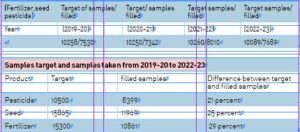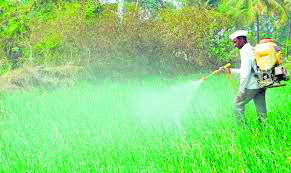The Agriculture and Farmers Welfare Department is collecting 25 to 30 percent fewer samples of seeds, fertilizers, and pesticides than the set target. The department provides pesticides, fertilizers, and seeds to farmers through licensed vendors in various districts. Despite the department’s claims of delivering better quality agricultural inputs to farmers, these claims have proven unsuccessful. In an effort to ensure quality, officials assert that they aim to collect the maximum number of samples of fertilizers, seeds, and pesticides, setting an annual target. However, contrary to these claims, the department is unable to meet its annual target for collecting samples of seeds, pesticides, and fertilizers.
Departmental statistics reveal a continuous shortfall in annual sample collection, falling below the set target. This situation necessitates additional efforts from the department. While the reasons for this shortfall may vary, it is a matter of serious concern in itself, particularly because the agricultural community is already facing challenges and disparities.
The data received from the department has revealed that the department collects 25 to 30 percent less samples of seeds, fertilizers and pesticides every year against the set target of filling 10258 samples in the year 2019-20 but the department could fill only 7530 samples resulting in 27 percent less sample collection. Likewise against a set target of collecting 10250, 10260 and 10089 samples in the year 2020-21, 2021-22 and 2022-23, a total of 7352, 8010 and 7689 were collected reporting a 28 percent, 24 percent less collection of samples respectively.
The information received revealed that in the last four years, the department has collected 20 percent less samples of pesticides than the prescribed target. During the period from 2019 to 2022-23, the department had set a target to fill 10500 samples of pesticide, but in these four years the department filled 8399 samples. In this context, the department could manage to fill 79.90 percent of the samples out of the target set in a period of four years.The department had set a target of collecting 2625 samples in the year 2019-20, 2625 in 2020-21, 2625 in 2021-22 and 2625 in 2022-23, but out of the set target, 2144, 2079, 2139 and 2097 samples were taken respectively in the above years. Out of a total set target of 10500 samples, 8399 samples have been taken over a period of four years.
Similarly, In a period of four years, the department has collected 25 percent less samples than the target set for seed samples. The department had set a target of collecting 3808, 3808, 3810 and 4438 seeds in 2019-20, 2020-21, 2121-11 and 2022-23, but during this period the department collected only 2892, 2786, 3251 and 3040 samples respectively. Thus, In this context, out of the 15864 sample target set by the department for four years, the department could manage to collect 11969 samples amounting to 75 percent of the set target.
Further, the data also depicted the less collection of fertilizers samples against the set target. It came to fore that the department had set a target of collecting 3825 samples every year during a four-year period 2019-20, 2020-21, 2121-11 and 2022-23, but the department did not meet the target of taking samples of these four years respectively as the department could manage to collect 2494, 2477, 2620 and 2552 sample of seeds respectively In this context, out of the 15300 seed sample target set, 10861 samples were collected depicting 29 percent less sample collection. Due to this, some sellers sell low quality seeds, pesticides and fertilizers to farmers which puts financial burden on the pocket of farmers already struggling on several fronts. Apart from this, the lower quality of seeds, fertilizers and pesticides result in poor quality of grain which affects the health of people.
Thus, it is clearly evident from the statistics that despite the tall claims, the department failed to collect samples of fertilizers, seeds and pesticide as per expectations and the not meeting the quality of seeds, pesticides and fertilizers to the standards requiring the departmental officials to come up maximum and timely collections of the samples.
























